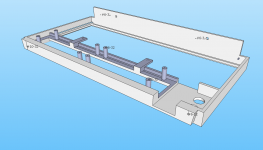smp
Veteran Member
I am looking for the PDP-8/I front panel bezel casting drawing, for a possible project to recreate the bezel in 3-D printing.
I looked on BitSavers in the /PDF/DEC/PDP8/ section and I see that the PDP-8/I Assembly Parts List is drawing A-PL-8I-0-0. There I see that the Control Panel Assembly drawing is E-AD-7005554-0-0. And, I see that the Control Panel Assembly contains the Bezel Casting Rework drawing E-IA-7406188-0-0.
I believe I would be looking for the Bezel Casting Rework drawing E-IA-7406188-0-0 in order to obtain all the dimensions necessary to describe the bezel for 3-D printing. However, so far, I have not been able to find a copy of the Bezel Casting Rework drawing.
Can anyone offer up a pointer to where I might be able to obtain a copy of the bezel drawing? Also, has anyone else ever investigated creating a copy of the DEC PDP-8/I front panel bezel? If so, I would appreciate any info or pointers on that project, so I don't go off and re-invent something that has already been accomplished.
Thanks for listening. Thanks in advance for any advice or pointers that you may have to offer.
smp
I looked on BitSavers in the /PDF/DEC/PDP8/ section and I see that the PDP-8/I Assembly Parts List is drawing A-PL-8I-0-0. There I see that the Control Panel Assembly drawing is E-AD-7005554-0-0. And, I see that the Control Panel Assembly contains the Bezel Casting Rework drawing E-IA-7406188-0-0.
I believe I would be looking for the Bezel Casting Rework drawing E-IA-7406188-0-0 in order to obtain all the dimensions necessary to describe the bezel for 3-D printing. However, so far, I have not been able to find a copy of the Bezel Casting Rework drawing.
Can anyone offer up a pointer to where I might be able to obtain a copy of the bezel drawing? Also, has anyone else ever investigated creating a copy of the DEC PDP-8/I front panel bezel? If so, I would appreciate any info or pointers on that project, so I don't go off and re-invent something that has already been accomplished.
Thanks for listening. Thanks in advance for any advice or pointers that you may have to offer.
smp


